How to Make an Herbal Tea Infusion & Decoction
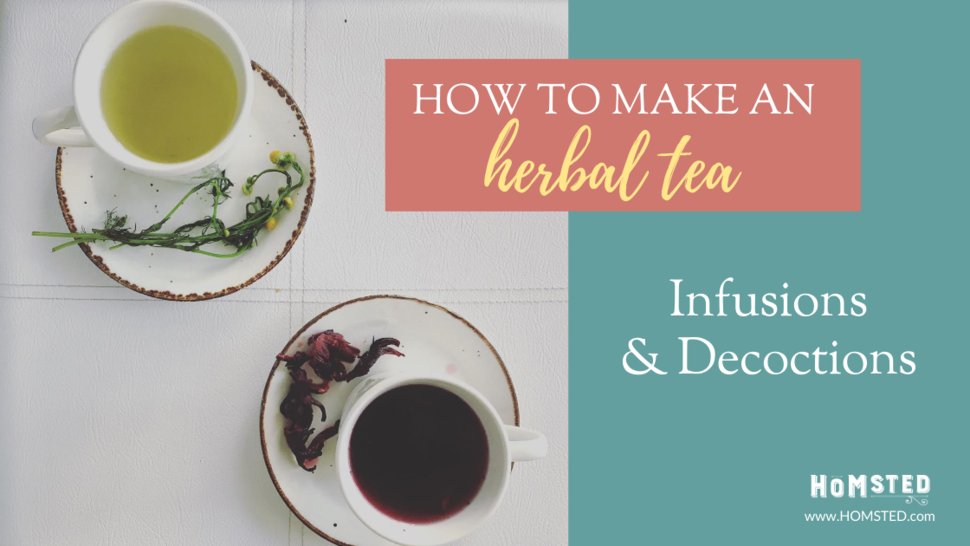
Teas and decoctions are, perhaps, some of the easiest and most effective modes of preparing herbal medicine. They comprise an indispensable option for extracting herbs and their preparation should be one of the very first lessons an aspiring herbalist should learn. In this article, we will discuss the proper techniques and practices for making effective tea. And, for those who wish to dig a little deeper, we will also touch on chemical and physical processes of extraction so that you can better understand why we suggest certain steps in tea and decoction preparation.
The Basics
When making a tea or decoction, one is simply using water to extract water-soluble (i.e. water friendly) chemicals from herbs. As it turns out, a large variety of plant chemicals (i.e. phytochemicals) are water-soluble, including carbohydrates, enzymes, mucilage, pectins, saponins, flavonoids & polysaccharides. Hot water further enhances the extraction potential of water by rupturing glands and cells that hold more phytochemicals. Not all phytochemicals are water-soluble, like most lipids and many alkaloids; hence the value of tinctures, oil infusions and other herbal preparations. But, for a vast majority of herbal needs, teas are a perfectly sufficient, if not pleasant way of enjoying and using herbs.
What is the Difference Between an Infusion and Decoction?
The difference between infusions (i.e. teas) and decoctions is simple: infusions are steeped and decoctions are simmered. The reason for this distinction is that some plant parts utilize more robust cell walls and, therefore, require a little more ‘coaxing’ to extract the chemicals of interest. For this reason, infusions are typically used with the softer parts of the plant such as leaves, flowers and aerial parts. With such herbs, cell walls are ‘softer’ and therefore rupture relatively easy; thus allowing water to enter cells. Furthermore, oil glands containing essential oils and other aromatic constituents are often easily ruptured by simply adding boiling water.
Cells of roots, barks, berries and seeds are often quite a bit tougher. Because of this, (covered) simmering of the materials is often necessary to break down cell walls. Mushrooms, too, often require decocting to extract the abundant polysaccharides that occur in them.
There are, of course, exceptions to these guidelines. For example, marshmallow root is best prepared by cold infusion, owing to the fact that it's polysaccharides are easy extracted with cold water alone. Hot water actually breaks down the chemicals of interest, thus making an inferior extraction. Valerian, too, is a root. But in this case, the volatile oils are best extracted using a hot water infusion rather than a decoction. In this case, simmering the root can cause loss of the volatile oils that are partially responsible for it’s sedating qualities. To make a long story short, you typically decoct roots, berries, seeds, barks and mushrooms and infuse leaves, and flowers. But, consult an herbalist, a good herbal book, or the infographics below to verify.
How to Make a Decoction:
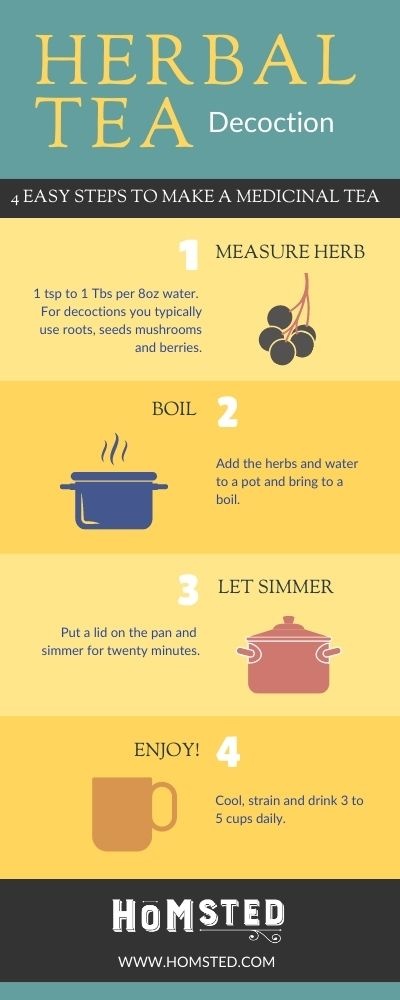
1. Measure herb
1 to 3 tsp per 8oz water. Since fresh herbs have a higher water content than dried herbs it can dilute your decoction so double the amount of herbs if you are using fresh herbs. If you grind, crush, or powder the herbs before decocting them you can enhance extraction.
2. Bring to a Boil
Fill a pan with cold water (placing the herbs directly into boiling water may make it difficult for the other plant constituents to be extracted) Add the herbs and bring to a boil.
3. Let Simmer
Cover the pan and simmer for twenty minutes.
Tip: If you want to make a tea blend that has the woodsy part of the plant and the softer part of a plant then:
- Decoct the woody herbs,
- Then add the remaining herbs to the pot when you remove it from the heat. Let all the herbs infuse together for 20 min with the lid on.
4. Enjoy
Cool, strain and drink. Refrigerate leftovers and use within a week.
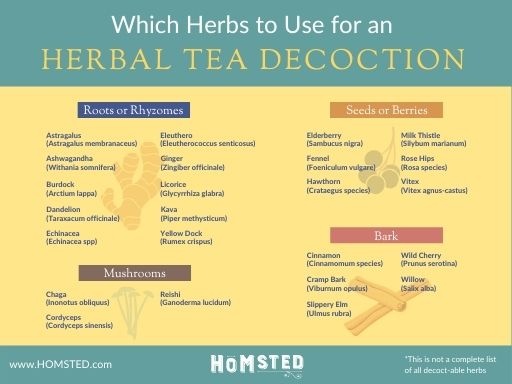
Decoction Recipes:
Detoxifying Blend
3 pt - Milk Thistle (Silybum marianum)
1 pt - Gentian (Gentiana lutea)
1.5 pt - Burdock (Arctium lappa)
1.5 pt - Dandelion Root (Taraxacum officinale)
1 pt - Ginger (Zingiber officinale)
Adaptagen (to help the body adapt to stress) Blend
4 pt - Ashwagandha (Withania somnifera)
2 pt - Eluthero (Elutherococcus senticosus)
.5 pt - Licorice (Glycyrrhiza glabra)
How to Make a Hot Infusion:
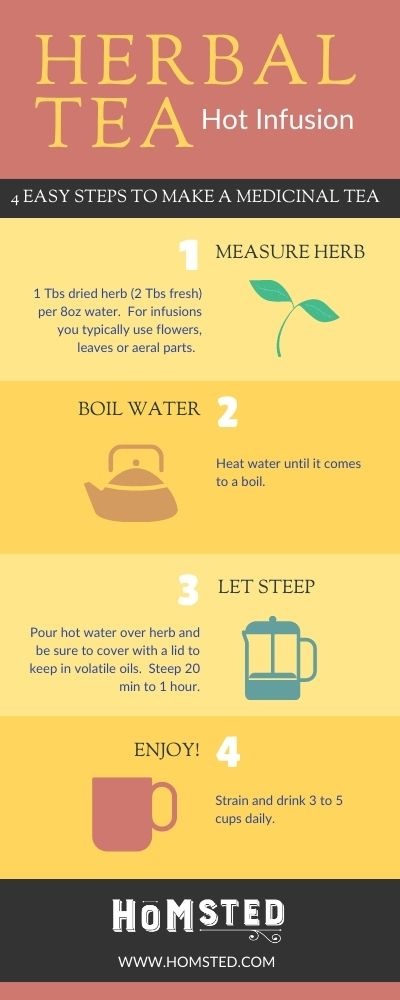
1. Measure herb
1 Tbsp dried herb (2 Tbsp fresh) per 8oz water. For infusions you typically use flowers, leaves or aerial parts.
2. Boil Water
Heat water until it comes to a boil.
3. Let Steep
Pour hot water over herb and be sure to cover with a lid to keep in the volatile oils. Steep 20 min to 1 hour.
Tip: Some herbs have more benefits if you steep for longer such as nettles, raspberry leaf, oatstraw and red clover.
4. Enjoy
Strain and drink warm or you can refrigerate or add ice for a cold beverage. You can also dilute your tea in water and add to a water bottle and sip throughout the day. If refrigerated it could be kept up to a week.
Hot Infusion Recipes:
Calming Blend:
2 parts linden
1 part passion flower
1 part chamomile
½ part rose petal
½ part lavender
Pinch of stevia leaf
How to Make a Cold Infusion:
1. Measure herb
1 Tbsp dried herb (2 Tbsp fresh) per 8oz water. Herbs typically used for cold infusions are mucilaginous herbs, bitter herbs and herbs with delicate essential oils. Examples of these herbs are: marshmallow root, slippery elm, astragalus, licorice root, peppermint, fresh lemon balm, fresh St. John’s wort, fresh flowers such as rose buds and lavender.
2. Let Steep
Pour cold water over the herb and cover with lid. Let the infusion sit for an hour to overnight.
Cold Infusion Recipe:
Tummy Tamer Tea
2 parts marshmallow
1 part chamomile
1 part peppermint
½ part fresh ginger
Tea Infusion Tools:
- A french press is an easy way to brew several cups of tea and is great for overnight brews and it includes a lid to keep all the volatile oils from escaping.
- The Infuser Mug or Infuser Tea Pot is also a great option. It comes with a cover to steep medicinal tea properly. You can also use the cover as a tray for the strainer once you're done steeping.
- If you plan to infuse in a mason jar you can use a tea ball, muslin bag or you can use a bean screen to strain.
- A cup top strainer is another good option if you want to brew one serving into your own mug. If you use this option be sure to get one with a lid or be sure to cover the mug with something like a plate for steeping.
- A bombilla is a great way to sip any loose tea on the go. No need for straining.
- A tea tumbler is a way to take your tea on any adventure. You can use it for iced or hot tea.
- If you plan to infuse your herbs directly in the water, you can strain after with a cheese cloth.
Dosing for Infusions and Decoctions:
- Acute ailments: we recommend one cup of tea every 2 hours (when awake).
- Chronic conditions: 1 cup of tea 3-4 times per day. We generally recommend using a medicinal tea for at least a week.
- Children dosage: to get a proper dosage divide the child’s weight by 150. For example for a 75-pound child, 75/150=.5 the child can have ½ the adult dose.
- Infant dosage: babies can receive the benefits of the medicinal tea through the mother’s breast milk about 20-30 minutes after the mother drinks the tea. You will just need to make sure that herbs are safe while breastfeeding.
Blending herbal tea is both a science and an art. Be sure to research which plants are safe with medications you are taking or work with an herbalist or Naturopath to develop a perfect formula for you.
Disclaimer: This information is intended only as a general reference for further exploration, and is not a replacement for professional health advice. This content does not provide format recommendations, toxicity levels, or possible interactions with prescription drugs. Accordingly, this information should be used only under the direct supervision of a qualified health practitioner. Reliance on any information provided by this article is solely at your own risk.



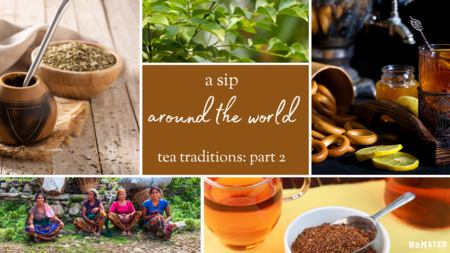

Comments